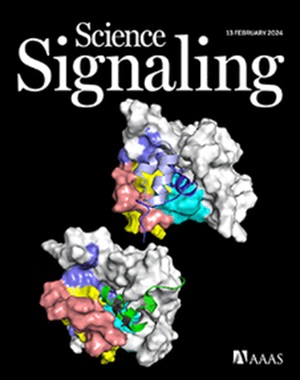生长因子信号传导至TSC复合体调控mTORC1的进化
IF 6.6
1区 生物学
Q1 BIOCHEMISTRY & MOLECULAR BIOLOGY
引用次数: 0
摘要
雷帕霉素(mTOR)复合物1 (mTORC1)的机制靶点整合了刺激(外源性生长因子)和细胞内营养和能量(细胞内营养和能量)细胞生长所必需的因子的信号。mTORC1中的蛋白激酶mTOR的激活导致下游底物的磷酸化,这些底物共同刺激生物量积累以驱动细胞生长。许多上游信号,特别是生长因子,通过诱导TSC蛋白复合体的结节硬化复合体2 (TSC2)亚基的磷酸化来调节mTORC1,这是mTORC1激活及其促进细胞生长的保守制动。对TSC蛋白复合物的低温电子显微镜研究表明,TSC2的磷酸化调控几乎完全发生在进化保守的核心结构元件之外的环中的残基上,并且在这些结构中没有分解。这些富含磷酸化的非结构化环是随着后生动物进化而来的,这表明多种生长因子对mTORC1的调节可能是随着复杂的机体计划和多种细胞类型的出现而进化的,以协调不同组织内和组织间的细胞生长和代谢。与TSC2的核心结构不同,这些环缺乏与疾病相关的错义突变。这些特征表明,TSC2上的调控环更容易受到进化变化的影响,从而使不同的信号聚集在TSC蛋白复合物上以调节mTORC1。本文章由计算机程序翻译,如有差异,请以英文原文为准。
Evolution of growth factor signaling to the TSC complex to regulate mTORC1
The mechanistic target of rapamycin (mTOR) complex 1 (mTORC1) integrates signals from factors that both stimulate (exogenous growth factors) and are essential for (intracellular nutrients and energy) cellular growth. Activation of the protein kinase mTOR within mTORC1 results in the phosphorylation of downstream substrates that collectively stimulate biomass accumulation to drive cell growth. Many upstream signals, especially growth factors, regulate mTORC1 by inducing the phosphorylation of the tuberous sclerosis complex 2 (TSC2) subunit of the TSC protein complex, a conserved brake on mTORC1 activation and its promotion of cell growth. Cryo–electron microscopy studies of the TSC protein complex have revealed that this phosphoregulation of TSC2 occurs almost exclusively on residues in loops that are outside of the evolutionarily conserved core structural elements and that did not resolve in these structures. These phosphorylation-rich unstructured loops evolved with metazoans, suggesting that the regulation of mTORC1 by diverse growth factors likely evolved with the emergence of complex body plans and diverse cell types to coordinate cell growth and metabolism within and across distinct tissues. Unlike the core structure of TSC2, these loops lack disease-associated missense mutations. These features suggest that the regulatory loops on TSC2 are more amenable to evolutionary changes that enable diverse signals to converge on the TSC protein complex to regulate mTORC1.
求助全文
通过发布文献求助,成功后即可免费获取论文全文。
去求助
来源期刊

Science Signaling
BIOCHEMISTRY & MOLECULAR BIOLOGY-CELL BIOLOGY
CiteScore
9.50
自引率
0.00%
发文量
148
审稿时长
3-8 weeks
期刊介绍:
"Science Signaling" is a reputable, peer-reviewed journal dedicated to the exploration of cell communication mechanisms, offering a comprehensive view of the intricate processes that govern cellular regulation. This journal, published weekly online by the American Association for the Advancement of Science (AAAS), is a go-to resource for the latest research in cell signaling and its various facets.
The journal's scope encompasses a broad range of topics, including the study of signaling networks, synthetic biology, systems biology, and the application of these findings in drug discovery. It also delves into the computational and modeling aspects of regulatory pathways, providing insights into how cells communicate and respond to their environment.
In addition to publishing full-length articles that report on groundbreaking research, "Science Signaling" also features reviews that synthesize current knowledge in the field, focus articles that highlight specific areas of interest, and editor-written highlights that draw attention to particularly significant studies. This mix of content ensures that the journal serves as a valuable resource for both researchers and professionals looking to stay abreast of the latest advancements in cell communication science.
 求助内容:
求助内容: 应助结果提醒方式:
应助结果提醒方式:


